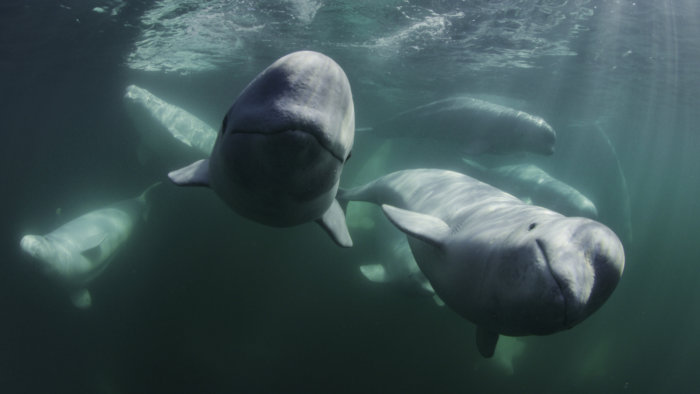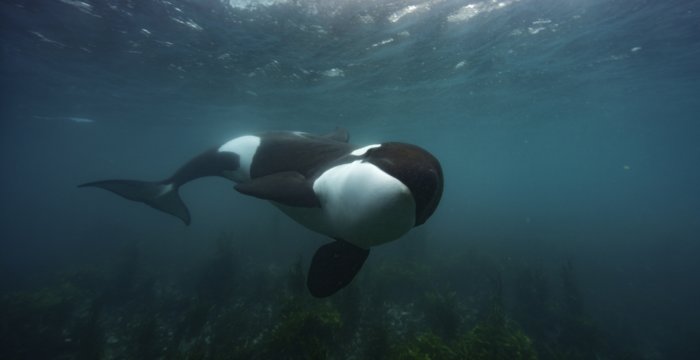National Geographic photographer and award-winning photojournalist Brian Skerry has always been drawn to marine life and underwater species, but there was something about whales that piqued his interest. As he says, we as human beings are living on the same planet with a highly-intelligent alien species, and although from just a glance we seem vastly different, there are some points of culture that actually bind us with nature more than we think.
In Disney+’s latest docuseries, ‘Secrets of Whales,’ Skerry—along with a crew of scientists, cameramen and a strong producing team including director James Cameron—delve deep into five different species: narwhals, humpbacks, belugas, sperm whales and orcas. Over a three year period and 24 different locales around the globe, Skerry and the crew were able to capture never-before-seen moments with whales, some of which have stumped the scientific community for a long time. But the biggest takeaway from the series may just be the discovery of the sense of culture that these creatures seem to have, even miles below the surface.
Skerry sat down with Metro to discuss more on what went into making ‘Secrets of Whales.’

You have a lot of experience with marine environments, so why chose to focus on whales?
That’s a good question—I love everything in the ocean, but there is something very special about whales. I write in my book: To be in the company of whales is sort of to have this rarified life experience that these are big-brained, highly cognitive, sentient animals, and as we talk about in ‘Secret of Whales,’ it’s about culture. So, in the times that I’ve spent with whales over the years, the experience of being allowed into their world—they are very aware of me when we’re in the water—and they can choose to swim away and 85% of the time they do, but when they actually engage with you it’s very special.
For me, when I created the ‘Secrets of the Whales,’ it was based on my love of those animals and wanting to tell a multi-species story. But I spent a decade coming up with a narrative and what was going to be the way to connect the dots. After reading a lot of scientific papers and talking to scientists and researchers and attending conferences, I sort of saw this theme of culture emerging and the fact that whales, like humans within a genetically identical species, are doing things differently. They isolate by language, they have food preferences, they teach their young, they’re passing on not only the skills that the young need to survive but their ancestral traditions. They have singing competitions, they play games, they share grief.
So, to me, that was a game-changer. If we could see the ocean through the lens of these animals that have rich cultures, then that changes our relationship in the actual world. You can’t un-know that and maybe we will be better stewards of the planet by doing that. It wasn’t overtly a conservation story, but it could have profound impacts if people understand that message.
How were you able to narrow down which whale species you wanted to study and the locations you wanted to travel to?
That came about through research really. It started with sperm whales. The scientist who really helped me form the foundation has become a good friend, his name is Dr. Shane Gero. He’s from Ottawa, but for the last 15 years he’s worked with sperm whales in the Eastern Caribbean, and he sort of helped me form this idea.
I knew that Sperm Whales were going to be a fundamental foundation for the story, but then I extrapolated—I looked at humpbacks, I read papers about the horizontal transmission of culture through the humpback song, or, how they were doing this generational learning or communal feeding of humpbacks when they migrate from Hawaii to Alaska. 2,500 whales go there but only about 60 engage in this bubble neck feeding community—that’s described as culture.
I looked at Orca, and their food preferences in different parts of the world. In New Zealand they like sting rays, and in the Norwegian Arctic they like herring, or in the Falkland Islands they like elephant seals and they develop strategies…But that’s unique in the world among animals to do that. So, I knew that there were certain places where you could have some degree of predictability by talking to researchers [on] where you can find certain animals at a certain time of the year. I sort of settled on the animals that I was drawn too, but also, on ones that would be diverse.

Going into this, did you have certain expectations and were they met or surpassed?
Before going into any location, I would have a shot-list in my mind that would sort of sketch out based on the research I had done in the two previous years. I guess I wouldn’t say it was an expectation, but it was a big hope. You hope that the science and everything comes together so you can get these things, but you know, in the book, I describe the Venn Diagram of whale photography. If you draw all of these sort of circles that overlap in the end you end up with a very small bullseye or circles of things that have to go right: The weather has to be good, the whales have to be there, you have to be able to get close to them, the visibility has to be good, they have to let me into their world. Most of the time we’re free-diving, so I’m holding my breath or other camera-men are holding their breath and we’re diving down 20-30-50-60 feet, so for a couple of minutes we have to capture behavior.
There are just so many things we can’t control. So, our expectations were met, our hopes were met, and we succeeded…We actually got things that we never would have scripted because it would have been too much of a dream really.
There are a lot of moments from the series that stuck out to me as a viewer. What are some moments that truly surprised you?
The orca feeding me a stingray in New Zealand, I would never have dreamed that something like that would happen. I had limited time on that trip, I had been in five or six southern countries, came from six weeks in the Canadian Arctic, was home for two days and then went to New Zealand and got this extraordinary moment.
Then, with sperm whales, being able to see for the very first time a six-month-old sperm whale calf nursing with the mom being so relaxed and trusting and allowing me to free-dive down 50 feet and get within a few meters of her and her little baby there. It’s something that has never been seen before. The scientists I showed it to that night said there’s an old saying in the whale biology world that says someday we will know everything there is to know about whales, except for how a sperm whale calf nurses. They couldn’t figure out how that jaw would work, and here we have this frame-by-frame analysis.
For the Beluga Whales in the arctic, I designed and built these remote cameras and put them in a shallow-water estuary where you’re not even allowed to go in the water, and if you put as much as a toe in the water 700 whales would stampede out. So, it was all very speculative and to get these moments of new-born beluga whale calves playing games with stones and rubbing their skin on the gravel as a natural exfoliant—all of this stuff was not very expected, but very welcome.

What do you hope audiences take away from the series?
I would hope that audiences are entertained, and they like it… But at the end of the day, that they can see the ocean and our planet through the lens of the culture of another species, that like us have rich traditions that are important to them. They celebrate identity, they grieve, they share joy, they play games and I think it’s a reminder of things that we already know.
Human connections are important, we are social creatures, we get on the hamster wheel of life sometimes with ambition and vocation, and what I was reminded with the whales was they make time every so often to stop and play and reaffirm those bonds. We need that. They are like us and they are different from us, but we share this planet with a highly intelligent alien species and you can’t un-know that. Once you see that, it changes our perception. We are not above or apart from nature, but we’re directly connected to it… And how wonderful is that?
‘Secrets of Whales’ premieres on Earth Day, April 22, on Disney+




























